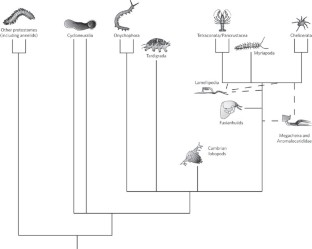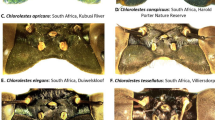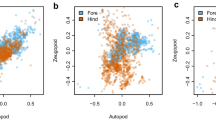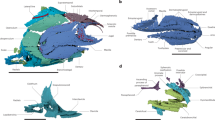Abstract
The past two decades have witnessed profound changes in our understanding of the evolution of arthropods. Many of these insights derive from the adoption of molecular methods by systematists and developmental biologists, prompting a radical reordering of the relationships among extant arthropod classes and their closest non-arthropod relatives, and shedding light on the developmental basis for the origins of key characteristics. A complementary source of data is the discovery of fossils from several spectacular Cambrian faunas. These fossils form well-characterized groupings, making the broad pattern of Cambrian arthropod systematics increasingly consensual.
This is a preview of subscription content, access via your institution
Access options
Subscribe to this journal
Receive 51 print issues and online access
$199.00 per year
only $3.90 per issue
Buy this article
- Purchase on Springer Link
- Instant access to full article PDF
Prices may be subject to local taxes which are calculated during checkout




Similar content being viewed by others
References
Darwin, C. On the Origin of Species by Means of Natural Selection, or the Preservation of Favoured Races in the Struggle for Life (John Murray, 1859).
Bowler, P. J. Life's Splendid Drama: Evolutionary Biology and the Reconstruction of Life's Ancestry (Chicago Univ. Press, 1996).
Ballard, J. W. O. et al. Evidence from 12S ribosomal-RNA sequences that onychophorans are modified arthropods. Science 258, 1345–1348 (1992).
Telford, M. J., Bourlat, S. J., Economou, A., Papillon, D. & Rota-Stabelli, O. The evolution of the Ecdysozoa. Phil. Trans. R. Soc. Lond. B 363, 1529–1537 (2008).
Dunn, C. W. et al. Broad phylogenomic sampling improves resolution of the animal tree of life. Nature 452, 745–749 (2008). This paper provides the most recent analysis of the relationships of the Metazoa, using a broadly sampled phylogenomic-scale data set.
Dzik, J. & Krumbiegel, G. The oldest 'onychophoran' Xenusion: a link connecting phyla? Lethaia 22, 169–182 (1989).
Eernisse, D. J., Albert, J. S. & Anderson, F. E. Annelida and Arthropoda are not sister taxa — a phylogenetic analysis of spiralian metazoan morphology. Syst. Biol. 41, 305–330 (1992).
Aguinaldo, A. M. A. et al. Evidence for a clade of nematodes, arthropods and other moulting animals. Nature 387, 489–493 (1997). This classic paper provided the first strong evidence for the clade Ecdysozoa.
Wagele, J. W., Erikson, T., Lockhart, P. & Misof, B. The Ecdysozoa: artifact or monophylum? J. Zoolog. Syst. Evol. Res. 37, 211–223 (1999).
Philip, G. K., Creevey, C. J. & McInerney, J. O. The Opisthokonta and the Ecdysozoa may not be clades: stronger support for the grouping of plant and animal than for animal and fungi and stronger support for the Coelomata than Ecdysozoa. Mol. Biol. Evol. 22, 1175–1184 (2005).
Rogozin, I. B., Thomson, K., Csueroes, M., Carmel, L. & Koonin, E. V. Homoplasy in genome-wide analysis of rare amino acid replacements: the molecular-evolutionary basis for Vavilov's law of homologous series. Biol. Direct 3, 7 (2008).
Rogozin, I. B., Wolf, Y. I., Carmel, L. & Koonin, E. V. Analysis of rare amino acid replacements supports the Coelomata clade. Mol. Biol. Evol. 24, 2594–2597 (2007).
Rogozin, I. B., Wolf, Y. I., Carmel, L. & Koonin, E. V. Ecdysozoan clade rejected by genome-wide analysis of rare amino acid replacements. Mol. Biol. Evol. 24, 1080–1090 (2007).
Zheng, J., Rogozin, I. B., Koonin, E. V. & Przytycka, T. M. Support for the Coelomata clade of animals from a rigorous analysis of the pattern of intron conservation. Mol. Biol. Evol. 24, 2583–2592 (2007).
Copley, R. R., Aloy, P., Russell, R. B. & Telford, M. J. Systematic searches for molecular synapomorphies in model metazoan genomes give some support for Ecdysozoa after accounting for the idiosyncrasies of Caenorhabditis elegans . Evol. Dev. 6, 164–169 (2004).
Philippe, H., Lartillot, N. & Brinkmann, H. Multigene analyses of bilaterian animals corroborate the monophyly of Ecdysozoa, Lophotrochozoa, and Protostomia. Mol. Biol. Evol. 22, 1246–1253 (2005).
Webster, B. L. et al. Mitogenomics and phylogenomics reveal priapulid worms as extant models of the ancestral Ecdysozoan. Evol. Dev. 8, 502–510 (2006).
Irimia, M., Maeso, I., Penny, D., Garcia-Fernàndez, J. & Roy, S. Rare coding sequence changes are consistent with Ecdysozoa, not Coelomata. Mol. Biol. Evol. 24, 1604–1607 (2007).
Papillon, D., Perez, Y., Caubit, X. & Le Parco, Y. Identification of chaetognaths as protostomes is supported by the analysis of their mitochondrial genome. Mol. Biol. Evol. 21, 2122–2129 (2004).
Schmidt-Rhaesa, A., Bartolomaeus, T., Lemburg, C., Ehlers, U. & Garey, J. R. The position of the Arthropoda in the phylogenetic system. J. Morphol. 238, 263–285 (1998).
Budd, G. E. The morphology and phylogenetic significance of Kerygmachela kierkegaardi Budd (Buen Formation, Lower Cambrian, N Greenland). Trans. R. Soc. Edinb. 89, 249–290 (1999).
Eriksson, B. J. & Budd, G. E. Onychophoran cephalic nerves and their bearing on our understanding of head segmentation and stem-group evolution of Arthropoda. Arthropod Struct. Dev. 29, 197–209 (2000).
Nielsen, C. Animal Evolution: Interrelationships of the Animal Phyla (Oxford Univ. Press, 2001).
Mallatt, J. & Giribet, G. Further use of nearly complete, 28S and 18S rRNA genes to classify Ecdysozoa: 37 more arthropods and a kinorhynch. Mol. Phylogenet. Evol. 40, 772–794 (2006).
Bourlat, S. J., Nielsen, C., Economou, A. D. & Telford, M. J. Testing the new animal phylogeny: a phylum level analysis of the animal kingdom. Mol. Phylogenet. Evol. 49, 23–31 (2008).
Manton, S. M. The Arthropoda: Habits, Functional Morphology and Evolution (Clarendon, 1977).
Fortey, R. A., Briggs, D. E. G. & Wills, M. A. The Cambrian evolutionary 'explosion': decoupling cladogenesis from morphological disparity. Biol. J. Linn. Soc. 57, 13–33 (1996).
Boore, J. L., Lavrov, D. V. & Brown, W. M. Gene translocation links insects and crustaceans. Nature 392, 667–668 (1998). This paper details a rare genomic change supporting Pancrustacea rather than Atelocerata.
Giribet, G., Edgecombe, G. D. & Wheeler, W. C. Arthropod phylogeny based on eight molecular loci and morphology. Nature 413, 157–161 (2001).
Mallatt, J. M., Garey, J. R. & Shultz, J. W. Ecdysozoan phylogeny and Bayesian inference: first use of nearly complete 28S and 18S rRNA gene sequences to classify the arthropods and their kin. Mol. Phylogenet. Evol. 31, 178–191 (2004).
Richter, S. The Tetraconata concept: hexapod–crustacean relationships and the phylogeny of Crustacea. Org. Divers. Evol. 2, 217–237 (2002).
Ungerer, P. & Scholtz, G. Filling the gap between identified neuroblasts and neurons in crustaceans adds new support for Tetraconata. Proc. R. Soc. B 275, 369–376 (2008). This paper presents data typical of the high-quality morphological techniques now being used to address arthropod phylogeny.
Harzsch, S. & Hafner, G. Evolution of eye development in arthropods: phylogenetic aspects. Arthropod Struct. Dev. 35, 319–340 (2006).
Fanenbruck, M. & Harzsch, S. A brain atlas of Godzilliognomus frondosus Yager, 1989 (Remipedia, Godzilliidae) and comparison with the brain of Speleonectes tulumensis Yager, 1987 (Remipedia, Speleonectidae): implications for arthropod relationships. Arthropod Struct. Dev. 34, 343–378 (2005).
Sanders, H. L. The Cephalocarida and crustacean phylogeny. Syst. Zool. 6, 112–128 (1957).
Cook, C. E., Yue, Q. Y. & Akam, M. Mitochondrial genomes suggest that hexapods and crustaceans are mutually paraphyletic. Proc. R. Soc. B 272, 1295–1304 (2005).
Carapelli, A., Liò, P., Nardi, F., van der Wath, E. & Frati, F. Phylogenetic analysis of mitochondrial protein coding genes confirms the reciprocal paraphyly of Hexapoda and Crustacea. BMC Evol. Biol. 7 (suppl. 2), S8 (2007).
Siveter, D. J., Williams, M. & Waloszek, D. A phosphatocopid crustacean with appendages from the Lower Cambrian. Science 293, 479–481 (2001).
Zhang, X. G., Siveter, D. J., Waloszek, D. & Maas, A. An epipodite-bearing crown-group crustacean from the Lower Cambrian. Nature 449, 595–598 (2007).
Siveter, D. J., Sutton, M. D., Briggs, D. E. G. & Siveter, D. J. A new probable stem lineage crustacean with three-dimensionally preserved soft parts from the Herefordshire (Silurian) Lagerstatte, UK. Proc. R. Soc. B 274, 2099–2107 (2007). This paper provides valuable new data on a crustacean-like taxon considerably younger than the Cambrian faunas.
Wilson, H. M. Juliformian millipedes from the Lower Devonian of Euramerica: implications for the timing of millipede cladogenesis in the Paleozoic. J. Paleontol. 80, 638–649 (2006).
Fayers, S. R. & Trewin, N. H. A hexapod from the Early Devonian Windyfield chert, Rhynie, Scotland. Palaeontology 48, 1117–1130 (2005).
Boxshall, G. A. Crustacean classification: on-going controversies and unresolved problems. Zootaxa 1668, 313–325 (2007).
Friedrich, M. & Tautz, D. Ribosomal DNA phylogeny of the major extant arthropod classes and the evolution of myriapods. Nature 376, 165–167 (1995).
Pisani, D., Poling, L., Lyons-Weiler, M. & Hedges, S. The colonization of land by animals: molecular phylogeny and divergence times among arthropods. BMC Biol. 2, 1 (2004).
Edgecombe, G. D. Morphological data, extant Myriapoda, and the myriapod stem-group. Contrib. Zool. 73, 207–252 (2004).
Rota-Stabelli, O. & Telford, M. J. A multi criterion approach for the selection of optimal outgroups in phylogeny: recovering some support for Mandibulata over Myriochelata using mitogenomics. Mol. Phylogenet. Evol. 48, 103–111 (2008).
Dunlop, J. A. New ideas about the euchelicerate stem-lineage. Acta Zool. Bulg. (Suppl. 1) 9–23 (2005).
Budd, G. E. The Cambrian fossil record and the origin of the phyla. Integr. Comp. Biol. 43, 157–165 (2003).
Gehling, J. G. The case for Ediacaran fossil roots to the metazoan tree. Mem. Geol. Soc. India 20, 181–223 (1991).
Waggoner, B. M. Phylogenetic hypotheses of the relationships of arthropods to Precambrian and Cambrian problematic fossil taxa. Syst. Biol. 45, 190–222 (1996).
Ivantsov, A. Y. Vendia and other Precambrian 'arthropods'. Paleontol. J. 35, 335–343 (2001).
Jensen, S. The Proterozoic and earliest Cambrian trace fossil record; patterns, problems and perspectives. Integr. Comp. Biol. 43, 219–228 (2003).
Hou, X.-G., Aldridge, R. J., Bergström, J., Siveter, D. J. & Feng, X.-H. The Cambrian Fossils of Chengjiang, China (Blackwell Science, 2004).
Conway Morris, S., Peel, J. S., Higgins, A. K., Soper, N. J. & Davis, N. C. A Burgess Shale-like fauna from the Lower Cambrian of North Greenland. Nature 326, 181–183 (1987).
Briggs, D. E. G. & Collins, D. The arthropod Alalcomenaeus cambricus Simonetta, from the Middle Cambrian Burgess Shale of British Columbia. Palaeontology 42, 953–977 (1999).
Whittington, H. B. The lobopod animal Aysheaia pedunculata Walcott, Middle Cambrian, Burgess Shale, British Columbia. Phil. Trans. R. Soc. Lond. B 284, 165–197 (1978).
Budd, G. A Cambrian gilled lobopod from Greenland. Nature 364, 709–711 (1993).
Budd, G. E. Arthropod body-plan evolution in the Cambrian with an example from anomalocaridid muscle. Lethaia 31, 197–210 (1998).
Liu, J. N., Shu, D. G., Han, J., Zhang, Z. F. & Zhang, X. L. Morpho-anatomy of the lobopod Magadictyon cf. haikouensis from the Early Cambrian Chengjiang Lagerstatte, South China. Acta Zool. 88, 279–288 (2007).
Bergstrom, J. Opabinia and Anomalocaris, unique Cambrian arthropods. Lethaia 19, 241–246 (1986).
Budd, G. E. The morphology of Opabinia regalis and the reconstruction of the arthropod stem-group. Lethaia 29, 1–14 (1996).
Hou, X.-G. & Bergström, J. Fossils and Strata Vol. 45 (Wiley, 1997).
Størmer, L. On the relationship and phylogeny of fossil and recent Arachnomorpha. A comparative study in Arachnida, Xiphosura, Eurypterida, Trilobita and other fossil Arthropoda. Skr. Norske Vidensk-Akad. 5, 1–158 (1944).
Chen, J. Y., Waloszek, D. & Maas, A. A new 'great-appendage' arthropod from the Lower Cambrian of China and homology of chelicerate chelicerae and raptorial antero-ventral appendages. Lethaia 37, 3–20 (2004).
Budd, G. E. A palaeontological solution to the arthropod head problem. Nature 417, 271–275 (2002).
Chen, J. Y., Edgecombe, G. D., Ramskold, L. & Zhou, G. Q. Head segmentation in Early Cambrian Fuxianhuia — implications for arthropod evolution. Science 268, 1339–1343 (1995).
Waloszek, D., Chen, J. Y., Maas, A. & Wang, X. Q. Early Cambrian arthropods — new insights into arthropod head and structural evolution. Arthropod Struct. Dev. 34, 189–205 (2005).
Budd, G. E. Head structure in upper stem-group euarthropods. Palaeontology 51, 561–573 (2008).
Scholtz, G. & Edgecombe, G. D. The evolution of arthropod heads: reconciling morphological, developmental and palaeontological evidence. Dev. Genes Evol. 216, 395–415 (2006).
Cotton, T. J. & Braddy, S. J. The phylogeny of arachnomorph arthropods and the origin of the Chelicerata. Trans. R. Soc. Edinb. 94, 169–193 (2004).
Eriksson, B. J., Tait, N. N. & Budd, G. E. Head development in the onychophoran Euperipatoides kanangrensis with particular reference to the central nervous system. J. Morphol. 255, 1–23 (2003).
Walossek, D. & Muller, K. J. Upper Cambrian stem-lineage crustaceans and their bearing upon the monophyletic origin of Crustacea and the position of Agnostus . Lethaia 23, 409–427 (1990).
Telford, M. J. & Thomas, R. H. Demise of the Atelocerata? Nature 376, 123–124 (1995).
Damen, W. G. M., Saridaki, T. & Averof, M. Diverse adaptations of an ancestral gill: a common evolutionary origin for wings, breathing organs, and spinnerets. Curr. Biol. 12, 1711–1716 (2002). The fascinating gene-expression data in this paper support the likely homology of insect wings and tracheae with crustacean gills.
Philippe, H. & Telford, M. J. Large-scale sequencing and the new animal phylogeny. Trends Ecol. Evol. 21, 614–620 (2006).
Thomas, R. H. & Telford, M. J. Appendage development in embryos of the oribatid mite Archegozetes longisetosus (Acari, Oribatei, Trhypochthoniidae). Acta Zool. 80, 193–200 (1999).
Acknowledgements
We thank A. Daley for assistance with photography and R. Copley for critically reading an earlier draft. Our research is supported by the Marie Curie Research Training Network ZOONET (grant number MRTN-CT-2004-005624).
Author information
Authors and Affiliations
Ethics declarations
Competing interests
The authors declare no competing financial interests.
Additional information
Reprints and permissions information is available at http://www.nature.com/reprints.
Correspondence should be addressed to the authors (graham.budd@pal.uu.se; m.telford@ucl.ac.uk).
Rights and permissions
About this article
Cite this article
Budd, G., Telford, M. The origin and evolution of arthropods. Nature 457, 812–817 (2009). https://doi.org/10.1038/nature07890
Published:
Issue Date:
DOI: https://doi.org/10.1038/nature07890
This article is cited by
-
Evolution of sex determination in crustaceans
Marine Life Science & Technology (2023)
-
An early Cambrian Sidneyia (Arthropoda) resolves the century-long debate of its head organization
Science China Earth Sciences (2023)
-
Reassessing a cryptic history of early trilobite evolution
Communications Biology (2022)
-
Towards a Comparative Study of Animal Consciousness
Biological Theory (2022)
-
The essence of life revisited: how theories can shed light on it
Theory in Biosciences (2022)
Comments
By submitting a comment you agree to abide by our Terms and Community Guidelines. If you find something abusive or that does not comply with our terms or guidelines please flag it as inappropriate.



